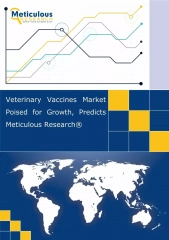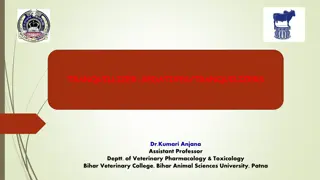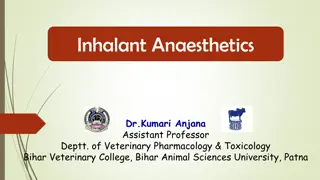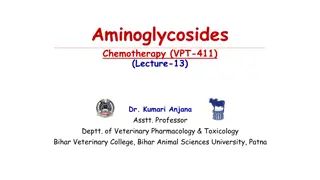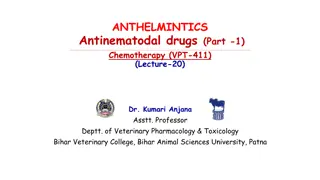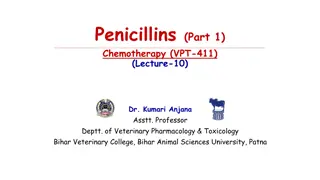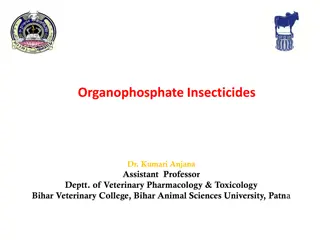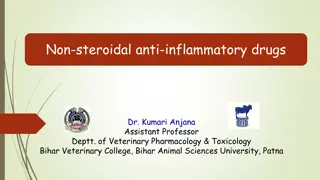Understanding Neurohumoural Transmission in Veterinary Pharmacology
Neurohumoural transmission in the field of veterinary pharmacology involves the communication of nerve messages through the release of chemical messengers. This process includes axonal conduction and junctional transmission. The historical aspects of neurohumoural transmission highlight key discoveries by scientists like Dubois Raymond, Otto Loewi, and Sir Henry Dale. Criteria for identifying a neurohumoural transmitter are detailed, emphasizing the presence, release, and effects of the substance. Understanding the steps and criteria involved in neurohumoural transmission is crucial for pharmacological research and application in treating animals.
- Veterinary Pharmacology
- Neurohumoural Transmission
- Chemical Messengers
- Historical Aspects
- Animal Health
Download Presentation

Please find below an Image/Link to download the presentation.
The content on the website is provided AS IS for your information and personal use only. It may not be sold, licensed, or shared on other websites without obtaining consent from the author. Download presentation by click this link. If you encounter any issues during the download, it is possible that the publisher has removed the file from their server.
E N D
Presentation Transcript
Neurohumoural Transmission Dr. Nirbhay Kumar Asstt. Professor & Head Deptt. of Veterinary Pharmacology & Toxicology Bihar Veterinary College, Bihar Animal Sciences University, Patna
Neurohumoural Transmission Neurohumoural transmission implies that nerves transmit their message across synapses and neuroeffector junctions by the release of humoural (chemical) messengers. Steps involved: 1. Axonal conduction 2. Junctional Transmission
Historical aspects 1857, Dubois Raymond : Observed similarity between transmission of nerve impulse produced electrically as well as by chemical substances such as NH3, lactic acid etc. 1901, Lewandowsky & Langley : Noted independently the similarity between the effects of injection of extracts of the adrenal gland and stimulation of sympathetic nerves. 1910, Berger & Dale : Noted that the effect of sympathetic nerve stimulation were more closely produced by primary sympathomimetic amines, then by secondary sympathomimetic amines. 1914, Sir Henry Dale : Thoroughly investigated the pharmacological properties of ACh which produced responses exactly similar to parasympathetic nerve stimulation and he introduced the term parasympathomimetic to characterize the effects of ACh.
Historical aspects continued . 1921, Otto Loewi : He provided the first direct evidence for the chemical mediation of nerve impulses by peripheral release of specific chemical agents. Otto Loewi Experiment 1946, Von Euler : He showed that the sympathetic transmitter is noradrenaline.
Criteria for being a Neurohumoural Transmitter To be considered as a post-junctionally acting neurohumoural transmitter a substance must fulfill the following criteria It should be present in the presynaptic neurone (usually along with the enzymes synthesizing it). It should be released in the medium following nerve stimulation. Its application should produce responses identical to those produced by nerve stimulation. Its effects should be antagonized or potentiated by other substances which similarly alter effects of nerve stimulation.
Steps involved in Neurohumoural Transmission [I]. Axonal Conduction: Figure : A typical action potential in an axon. (a) Potential distribution across the axonal membrane (b) Relationship between membrane potentials.
Steps involved in Neurohumoural Transmission continued.. Drugs/ Toxins that interfere Axonal Conduction: The axonal conduction is blocked by certain toxins such as Tetradotoxin (puffer fish poison) and Saxitoxin (shell fish toxin), which interfere with the Na+ entry across the neuronal membrane during depolarization. Batrachotoxin, a steroidal alkaloidal toxin elaborated by a type of South American frogs, paralyses the nerves by persistent depolarization as a result of increase in Na+ influx. Local anaesthetics act by preventing the Na+ influx and depolarization of the nerve.
Steps involved in Neurohumoural Transmission continued.. [II]. Junctional Transmission: (i) Storage transmitter: and release of the The non-peptide neurotransmitters are largely synthesized in the region of axonal terminals and stored there in synaptic vesicles. Peptide found in large dense-core vesicles which are transported down the axon from their site of synthesis in the cell body. neurotransmitters are
Steps involved in Neurohumoural Transmission continued.. (ii) Combination of the transmitter with post-junctional receptors and production of the post-junctional potential: EPSP : Increase in permeability to all cations causes Na+ or Ca2+ influx (through fast or slow channels) which cause depolarization followed by K+ efflux (repolarization). IPSP : Increase in permeability to smaller ions, i.e. K+ and Cl (hydrated K+ ion is smaller than hydrated Na+ ion) only, so that K+ moves out and Cl moves in (in the direction of their concentration gradients).
Steps involved in Neurohumoural Transmission continued.. (iii) Initiation of post-junctional activity: EPSP Initiates a propagated action potential in the post-synaptic neurone or skeletal or cardiac muscle. In smooth muscles, enhance muscle tone and in gland cells, initiates secretion through Ca2+ mobilization. IPSP Found in neurons and smooth muscles but not in skeletal muscles, will tend to oppose excitatory potentials simultaneously initiated by other neuronal sources. (iv) Destruction or dissipation of the transmitter: Following its combination with the receptor, the transmitter is either locally degraded (e.g. ACh) or is taken back into the pre-junctional neurone by active uptake or diffuses away (e.g. NE, GABA). Rate of termination of transmitter action governs the rate at which responses can be transmitted across a junction (1 to 1000/ second).






